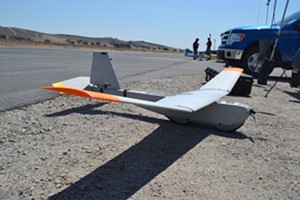
Locals who know nothing about unmanned drones beyond what they read in international headlines may soon be getting a closer look at the infamous flying contraptions.
The Santa Maria Airport recently entered into a teaming agreement with two other airports that are applying to be a drone test site for the Federal Aviation Administration. That means if the Indian Wells Valley Airport District or Ventura’s Southern California Unmanned Systems Alliance—both of which applied to the Unmanned Aircraft Systems program— is selected, Santa Maria’s airport could get involved, too.
Santa Maria Public Airport General Manager Chris Hastert explained that the agreement “only commits the Santa Maria airport to meet with one of the other two entities if they are successful in becoming a test site, and possibly serve as an alternate launch and recovery site if all local concerns are met.”
So even if everything rolls smoothly forward, don’t expect Northern Santa Barbara County skies to grow dark with craft.
Just a few weeks before the teaming agreement, a Joint Interagency Field Exploration (JIFX) event run by the Naval Postgraduate School in Monterey brought almost 70 drone experiments to Camp Roberts—a dusty, expansive National Guard base straddling the border between San Luis Obispo and Monterey counties—giving the Central Coast a taste of what could someday be whirring around above our collective heads in this country.
On one day of the Aug. 5 through 8 event, a sizeable crowd of journalists, defense contractors, and military officers clustered around a drone—only the size of a personal pizza—as it hovered at eye-level.
Behind the controls of the InstantEye drone, Thomas Vaneck of Boston-area tech company Physical Sciences Inc. grinned, and flicked the joystick upward.
The assembled crowd oohed and aahed as the four-propeller drone shot directly up into the sky—recording the revelers in high definition.
Camp Roberts was invigorated by the event, which brought more than 400 scientists and consultants from as far away as Israel and the United Kingdom to experiment, tweak, and scout cutting-edge technology.
“We like to think of this event as a tech-oriented ‘Burning Man’ for government,” said Ray Buettner Jr., an associate professor at the Naval Postgraduate School and director of the JIFX event. “It’s a collaborative learning environment with minimal rules where producers can get feedback from their consumers.”
In the media “briefing tent” Buettner told the Sun that the school received more than 90 submissions for experimentation and/or demonstration—accepting slightly fewer than 70. An impressively crowded wall of white papers at the JIFX command center paid testament to that diversity of ideas.
Submissions ran the gamut: “Hands-Free Biometric Identification at a Distance,” “Situational Awareness Wrist Device,” “Small UAV Auto-Launch,” “Rapid Satellite Image Exploitation and Delivery.”

At the McMillian Airfield, host to many of the experiments, interests were identifiable by their attire. There was the rumpled semi-casual of journalists and academics, the stiff boots and camouflage of Army and Navy officers, and the branded polo shirts of defense contractors.
As drones buzzed, generators whirred, and people chattered, Timothy Chung—an assistant professor at the Naval Postgraduate School—prepared for the scintillatingly named Aerial Combat Swarm.
Chung explained that this experiment consisted of a 50 v. 50 drone challenge, with the red drone team taking on the blue drone team. The glider-shaped drones are cheap to make and easy to control.
“It’s 50 non-human cognitive entities interacting with 50 of the same in a space that’s both physical and temporal,” Buettner said. “That’s science fiction, man.”
“Drone” is something of a taboo word here. Where the alphabet soup runs thick and political correctness is a mandate, the preferred vernacular is unmanned aerial vehicle (UAV).
That said, the drones being tested at Camp Roberts were a long way from the missile-blasting Predator drones often deployed in the skies of Yemen, Pakistan, or Somalia.
Even the heaviest drones being tested here weigh a mere 22 pounds, and none of them are weaponized. Primary applications for these nimble, remote-operated drones include agriculture, surveillance, and disaster response.
Daniel Gerstein, the Department of Homeland Security’s Science and Technology Deputy Undersecretary, paid lip service to drone privacy concerns, saying discussing such matters was “very important” to his office.
Buettner, on the other hand, offered a more measured take.
“One of my jobs is to create a robust discussion around the ethics of ubiquitous data collection and armed lethal force,” Buettner said. “We are looking for inexpensive ways to make better decisions on the battlefield.”
Though the drones were the main attraction, roughly 25 percent of the experiments at Camp Roberts were in the fields of humanitarian aid and disaster relief.
Working under the blistering midday sun, Army personnel were constructing a structural insulated panel hut, a more durable form of temporary housing designed to be built in a mere six hours.
“When y’all get done here, I need one of those in my back yard,” quipped a passing Army officer.
FEMA officials, buzzing around in a specially-constructed “disaster recovery center,” were testing out their “cellular activity heat map,” which helps to locate those in need of rescue during a disaster.
“We like to think of it as ‘everyone helping everyone,’” said Desiree Matel-Anderson, FEMA’s chief innovation adviser.
As JIFX officials announced the imminent landing of a 13-pound Puma drone, observers gathered around the small airstrip.
Adam MacDonald, a business development director at AeroVironment—the company that makes the drone—enthusiastically described the radar-mapping abilities of the drone and its milestone certification on July 26 by the Federal Aviation Administration for civilian use. After the Puma landed, MacDonald flagged down an assistant carrying the drone from its landing site for a hands-on demo.
“Can you pass me that Puma, bro?” MacDonald asked.
Though no money changed hands at the JIFX event and many of the technologies are still in their beta phase, Buettner said he saw the future of the military scattered among these experiments.
“I get excited when I see people looking over new technology and saying ‘what if?’ or ‘maybe we could,’” Buettner said. “You can influence the views of officers, and you can influence which technologies make it to the battlefield—and we get to do both.”
Rhys Heyden is a staff writer for New Times, the Sun’s sister paper to the north. Contact him at [email protected]. Executive Editor Ryan Miller contributed to this story.
Additional photos from the Joint Interagency Field Exploration (JIFX) event held at Camp Roberts, August 5-8. Photos by Rhys Heyden.










